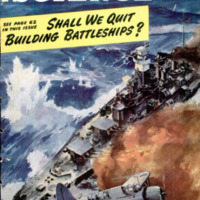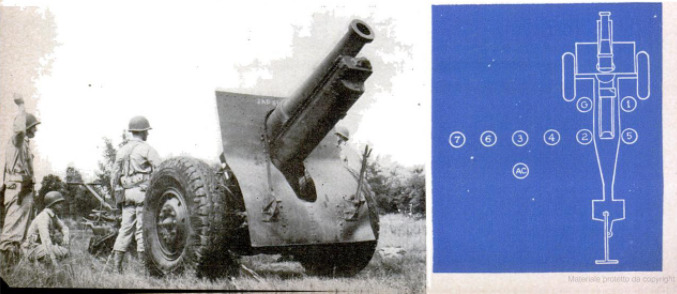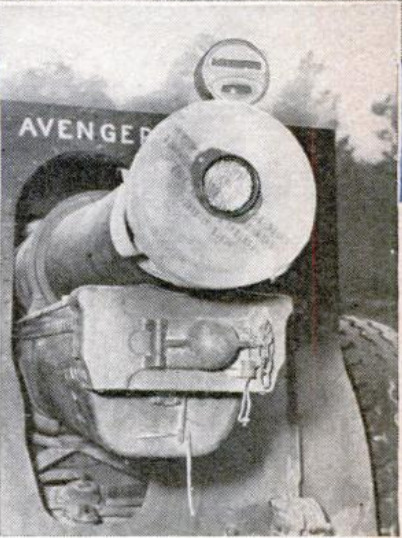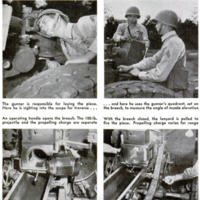-
Title (Dublin Core)
-
U. S. Army's 155 mm Howitzer
-
Article Title and/or Image Caption (Dublin Core)
-
Title: Reach and Punch
-
Subtitle: That's our 155 mm Howitzer
-
extracted text (Extract Text)
-
BLUNT, businesslike, and snub-nosed, the
U. S. Army's 155-millimeter howitzer is
a fast-moving medium artillery piece with
a wicked punch.
Unofficial Army talk indicates that the
155 was a particularly mean surprise to the
Japanese infantry and artillery on Bataan,
where our outnumbered troops put the
howitzers to good use during that bitter
struggle. The guns were in there barking
again in North Africa, and wherever our
troops have moved in force.
Like all guns of the howitzer type, the
155 has the advantage of extreme elevation
of the barrel, enabling it to lob shells in a
high arc over intervening hills.
It fires a projectile of slightly under 100 |
pounds, with the propelling charge loaded
separately. The base charge can be com-
bined with one to six powder increments,
to fire into zones of increasing range. Maxi-
mum effective range is around 10,500 yards.
Not one of the newest weapons in the
U. S. arsenal, the 155 is based on a Schnei-
der (French) design of 1918, The model
was an extremely efficient one, and the gun
itself, tube and breech, has been little
changed. Certain modifications have been
introduced, especially to make the weapon
move faster and handle more easily on the
road.
A battery of 155's, thundering along the
road to an assigned position, can halt, move
the guns into place, and open fire in less
than eight minutes. In action the normal
rate of fire is three rounds a minute for
each howitzer. They can be fired consider-
ably faster in an emergency, but the bar-
rel tends to heat up at an excessive rate.
In normal operations the 155's are used
as divisional artillery, supporting the gen-
eral line of the division wherever their
power is needed. They are thus medium
weapons between the lighter 105-mm. gun-
howitzers, which characteristically would
be operating with the division's combat
teams, and the much heavier 155-mm. rifles
(equivalent to six-inch naval guns) which
probably would be serving as army corps
artillery.
The most common assignments of the
155 howitzers are counter-battery fire or
interdiction and harassing fire. That is to
say, the shells are tossed at enemy artillery
positions, at supply dumps and strong
points, or at highways and crossroads
Where heavy enemy traffic is passing. The
objectives of fire are not only to smash at
hostile installations, vehicles, and person-
nel, but also to make whole areas of terrain,
roads, or populated districts at least tem-
porarily unusable for enemy forces.
The men who serve and care for these
guns speedily develop a remarkable affec-
tion for their husky, ugly-efficient charges.
As one sergeant explained:
“We can reach! And where we reach, we
got power!”
Most American crews soon endow their
guns with personality, and with picturesque
names painted on the shields. One battery
proudly emblazoned these titles on its four
guns: “Jap Slapper,” “Avenger,” “Nazi
Nightmare” and “Rising Sun Sinker.”
Other symbols painted on the guns have
a more practical purpose. Any four dis-
tinctive symbols would do for the four
guns of a battery, but the traditional heart,
diamond, club, and spade designs seem to
have been made to order for the purpose.
Each gun has one of these stenciled on it.
When the battery is moving up to a new
zone, an officer precedes it, selects a suit-
able firing position for each gun, and at
each of the four points sets up a small
standard carrying the corresponding sym-
bol and an arrow pointing in the direction
in which the gun should be pointed.
When the howitzers arrive they are
hauled to the indicated spots and wheeled
into position, pointing to their targets. The
men of each gun crew then hop down from
the prime mover, uncouple the piece, and
prepare to go into action, sinking the heavy
spade trail into the ground. It is understood
that the Army has been experimenting with
a new type of split trail for this howitzer,
but none has so far been officially adopted.
LOCKHEED CONSTELLATION, largest and fastest
land-based transport plane ever built, can
carry 55 soldiers plus a crew of nine across
the continent nonstop in less than nine hours,
flying above the weather at 20,000 to 35,000
feet. Four 2,000-hp. engines give it more
speed than a Zero fighter. The sharklike
body carries a triple tail which not only cuts
down over-all height but also gives added
control and safety.
TO REPLACE MEDICINE DROPPERS, which have
become scarce along with rubber, E. R.
Squibb & Sons is using a drop-dosage bottle
for some of its products. It is a version of
the two holes in the top of a condensed-milk
can long known in American kitchens. The
bottle is sealed under its cap with a new type
of cellulose film that has two holes punched
in it at opposite edges. For use, the bottle
is tilted and the contents are dropped out of
either of the holes at a rate which makes it
easy to judge the amount of liquid that has
been dispensed.
PLASTIC SHAVING BRUSHES re-
quiring no critical rubber
for their bristle settings
have become regular issue
in the U.S. Army to con-
serve strategic materials for
more vital war needs. An
additional saving has been
made in eliminating the cus-
tomary brass ring at the
base of the bristles without
affecting the permanence
of the settings. The plastic
has proved its worth in
tests, resisting cracking,
bending, and disintegration,
and withstanding immersion
in water heated to 160 de-
grees F. Two million of the
brushes have been ordered.
-
Contributor (Dublin Core)
-
John H. Walker (Article Writer)
-
William W. Merris (Photographer)
-
Language (Dublin Core)
-
eng
-
Date Issued (Dublin Core)
-
1943-04
-
pages (Bibliographic Ontology)
-
74-77
-
Rights (Dublin Core)
-
Public Domain (Google Digitized)
-
Archived by (Dublin Core)
-
Matteo Ridolfi
-
Marco Bortolami (editor)
 Popular Science Monthly, v. 142, n.4, 1943
Popular Science Monthly, v. 142, n.4, 1943








